Measuring Attacking Influence
We all know the saying “team X is just a one-man team”. In itself, it’s just a subjective statement, often caused by a strong dose of recency bias. One player of a team is temporarily more noticeable than usual, maybe he happens to be scoring lots of goals within a few weeks. Just recently, we witnessed a milder version of the same issue, as Robert Lewandowski was scoring goals at a completely unsustainable rate:
You are currently viewing a placeholder content from X. To access the actual content, click the button below. Please note that doing so will share data with third-party providers.
Despite it being obvious that such a run, which might be his career peak, would require a miracle to even last an entire month, people were quick to use those events to proclaim Lewandowski as the world’s number one striker and one of the best players. Not because of years of reliable service at a high level, not because of gradual improvements – just because he had a few matches where he managed to turn every chicken into a gold nugget. The only thing that prevented Bayern from being called a one-man team is that the strength of that squad is universally accepted. For the vast majority of football clubs, that would’ve been a perfect moment to be accused of being a one-man show.
“Goals are overrated.”
Goals come and go. Sometimes they happen, sometimes they don’t – even if the player did everything right. Analyzing someone’s goal output is always dubious, even more so when looked at in a micro-economic way. “Player X hasn’t scored in Y minutes” – often heard, rarely questioned. In itself, that stat doesn’t tell you much at all. Is it better to score 5 goals a season, distributed evenly, or to score 40 goals but with a big break in between? Sure, sometimes the player in question is out of form. Just as often it’s his teammates not supporting him well enough or the ball taking unlucky bounces.
What is all of this about, you might be wondering. We’re not just trying to prove a point, promise. We’ve decided to look at how dependent Bundesliga teams are on the output of individual players. For the reasons stated above, we did not use goals and assists. Instead, we used numbers that are just as easily accessible and more representative of the entire 90 minutes of a match: shots and key passes. It’s simple. Check how many key passes a player has played and how many shots he has taken, compare it with the entire team’s output. You end up with the percentage that more or less reflects the influence of that player. Combine the two numbers and you receive a number that rewards playmakers and finishers equally – for the lack of a better name, let’s call it AOP. Attacking Output Percentage. Sounds dumb fun, doesn’t it?
Attacking Output Percentage
This isn’t a highly complex analysis, we’ll be the first to admit that. It was never supposed to be. All we wanted was a visualization of dependence, an objectification of “one-man team-ness”. It is biased towards attacking players (otherwise it wouldn’t be the ATTACKING output percentage) so take it with a grain of salt when looking at build-up players. Without further ado, here’s how those numbers sum up Bayern’s season so far:
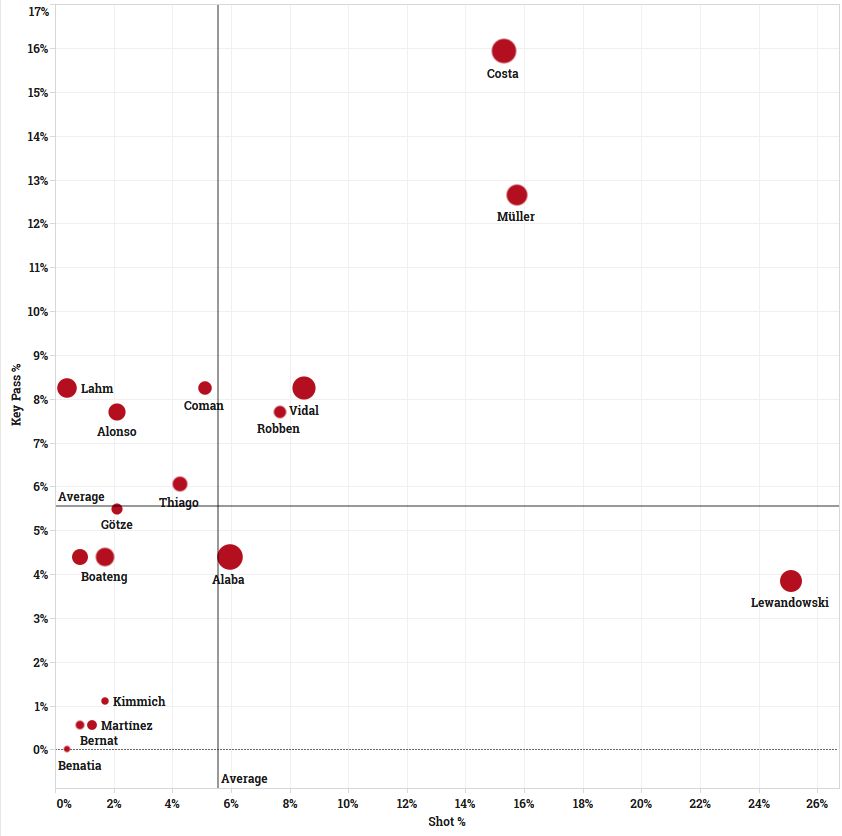
What can you spot? Robert Lewandowski has a very high output that is focused on finishing while Douglas Costa and Thomas Müller are highly involved both in terms of shooting and creating. Philipp Lahm for example is a good creator but refuses to shoot the ball (we didn’t need numbers for that). But there’s a big of a problem. Arturo Vidal more influential than Arjen Robben? Surely not! The reason is simple: those numbers are totals and thus dependent on playing time. To cover that, we’ve adjusted the size of the dots to represent the playing time. Arjen Robben’s dot is small because he hasn’t played much.
Of course it’s possible to just use the values per 90 minutes instead. Note: if a dot is very small but very far to the top right, it might be wise to ignore it as numbers per 90 minutes are very vulnerable to short appearances. For example, if a player is brought on after 80 minutes and plays one key pass, the number per 90 minutes will go through the roof. Here are the normalized stats for Bayern:
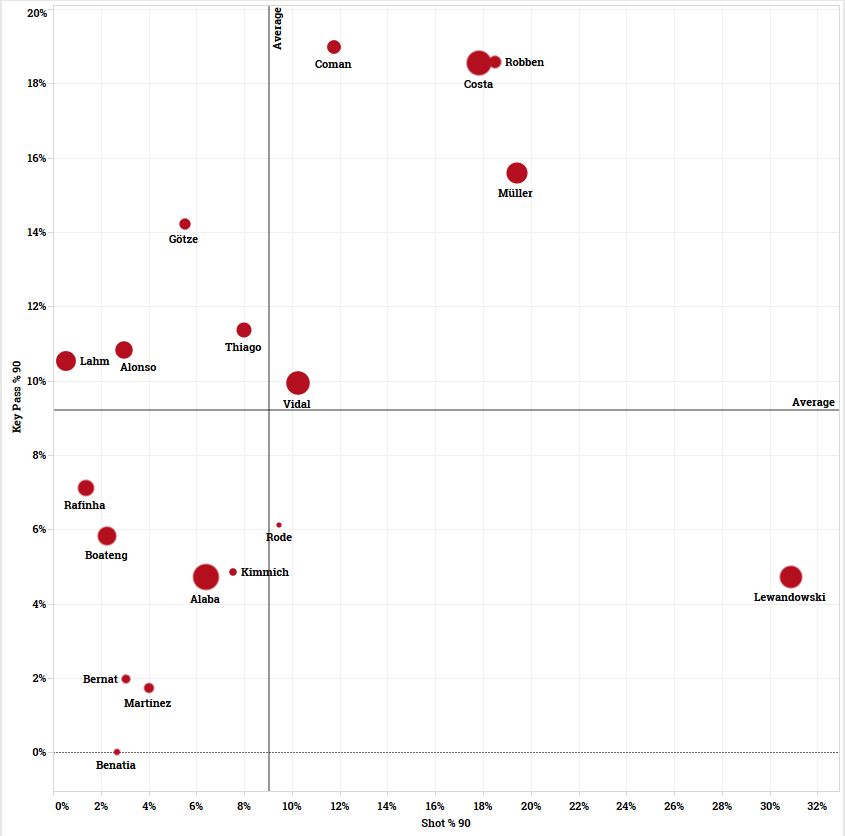
Looks more like you would’ve guessed, right? Arjen Robben with lots of influence again. As we mentioned earlier, you can put those stats into one number for a clearer visualization that makes no difference between passing and shooting. Here comes the AOP.
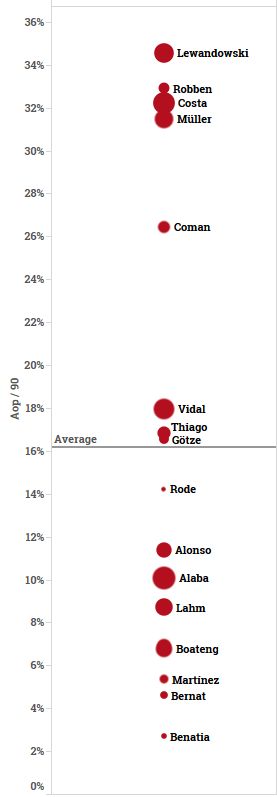
What does this tell us? First of all, Bayern are clearly no one-man team. You can see the importance of the attacking four (Lewandowski, Müller, Costa, Robben) and how Coman is getting close to their output at a young age. Behind that, you find the group of attacking-minded midfielders (Vidal, Thiago, Götze). Below average are the build-up men and defenders. Big surprises? Maybe not. But that’s what shows that this measurement works. But does the Bundesliga have any one-man teams? We have the answer.
Bundesliga AOPs
Let’s have a look at the entire league’s stats.
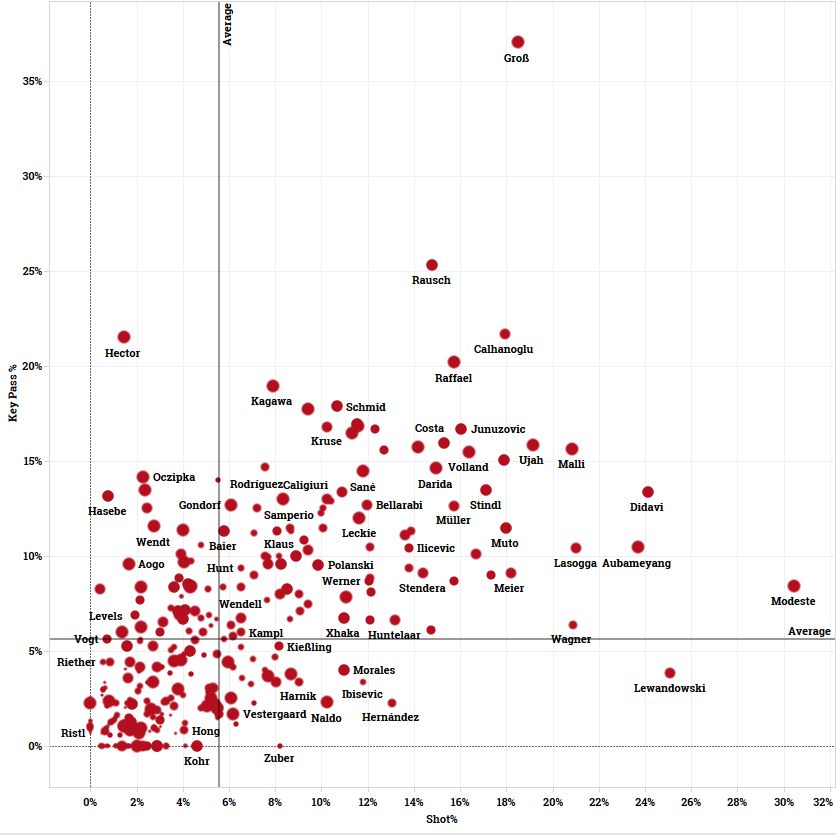
We already see a few suspicious ones. Looking at you, Pascal Groß. The graph per 90 minutes doesn’t show much of a difference except for a few “stat victims” who benefit from their short appearances. CLICK HERE to see the graphic for stats per 90 minutes. Let’s follow with the AOP rankings for each team.
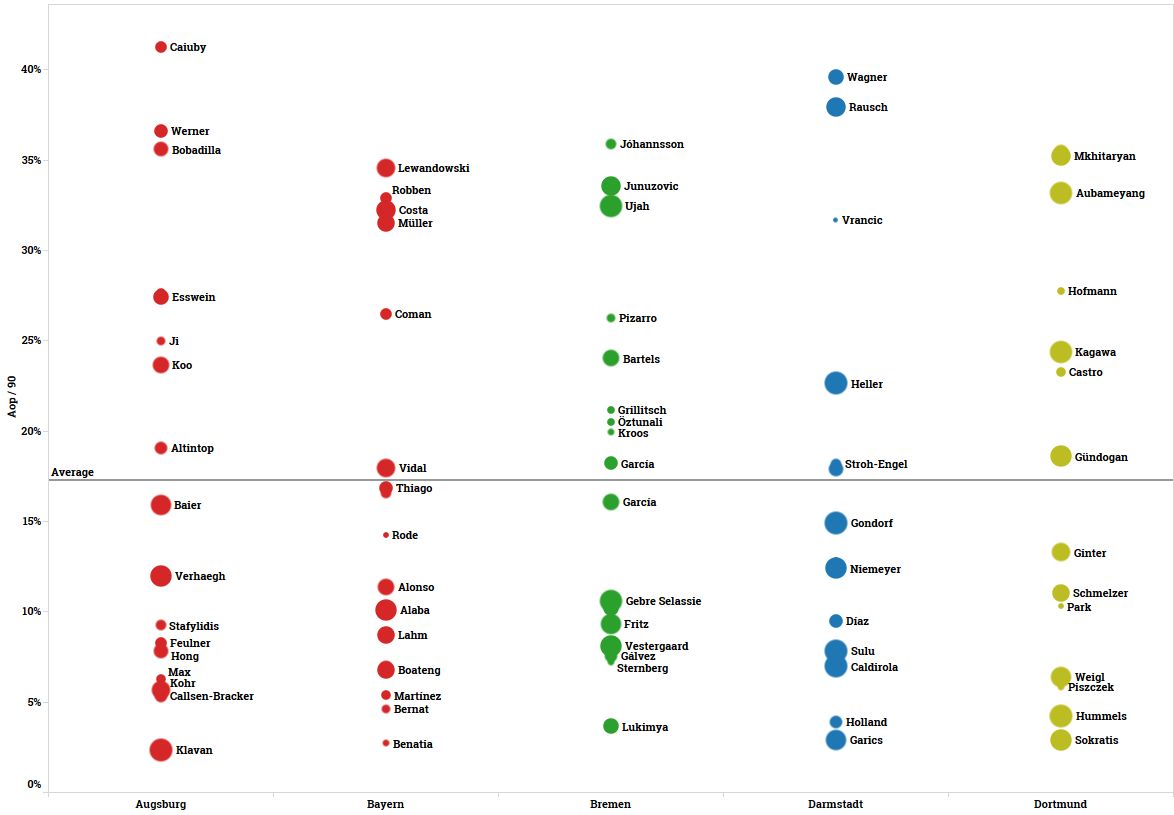
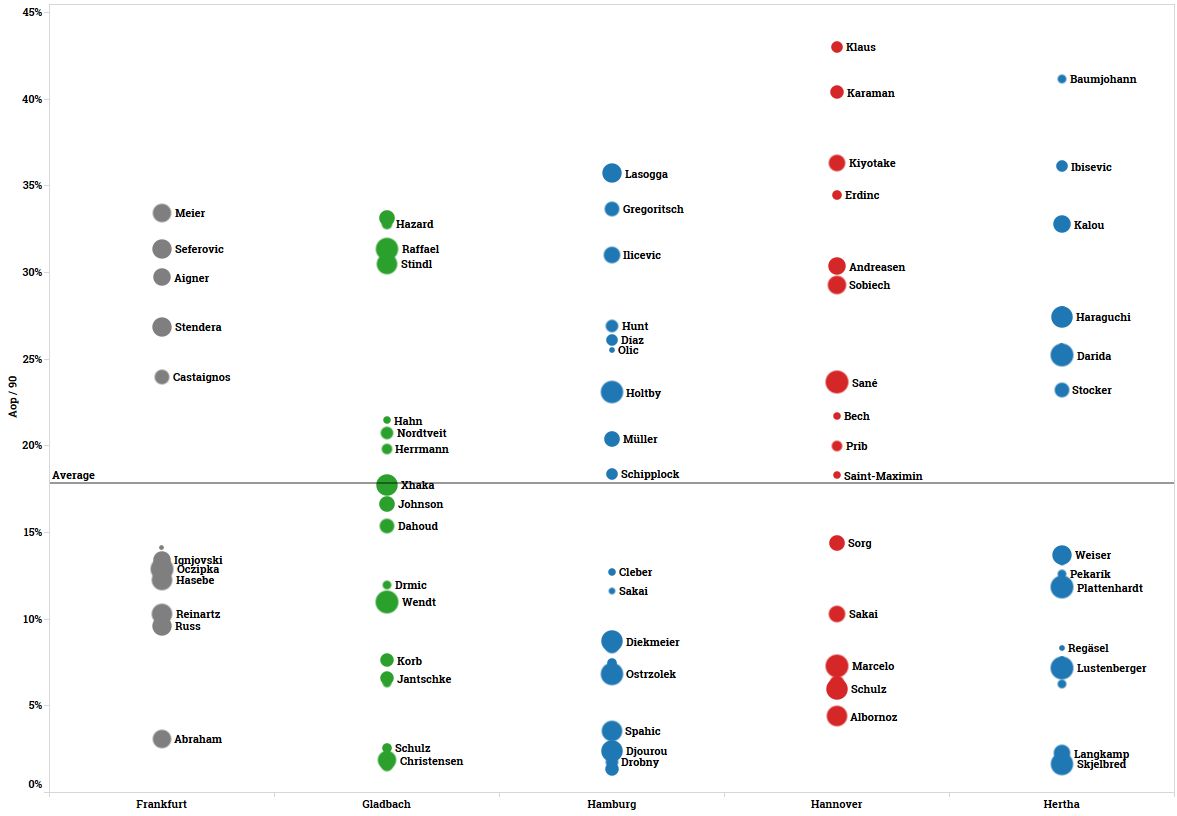
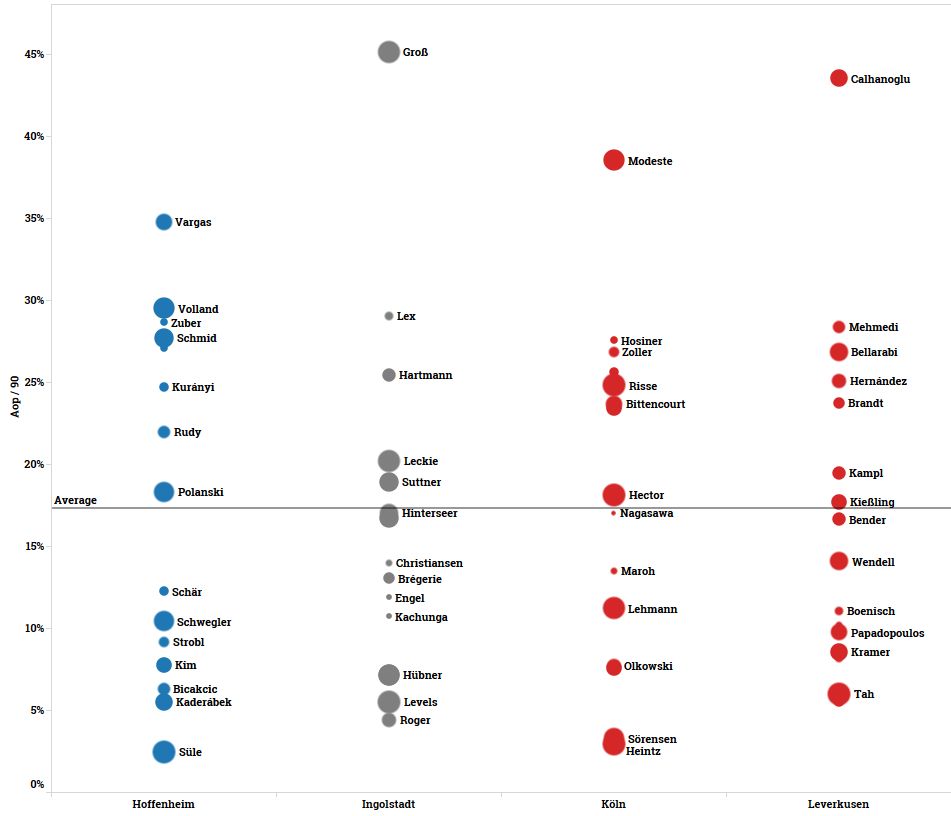
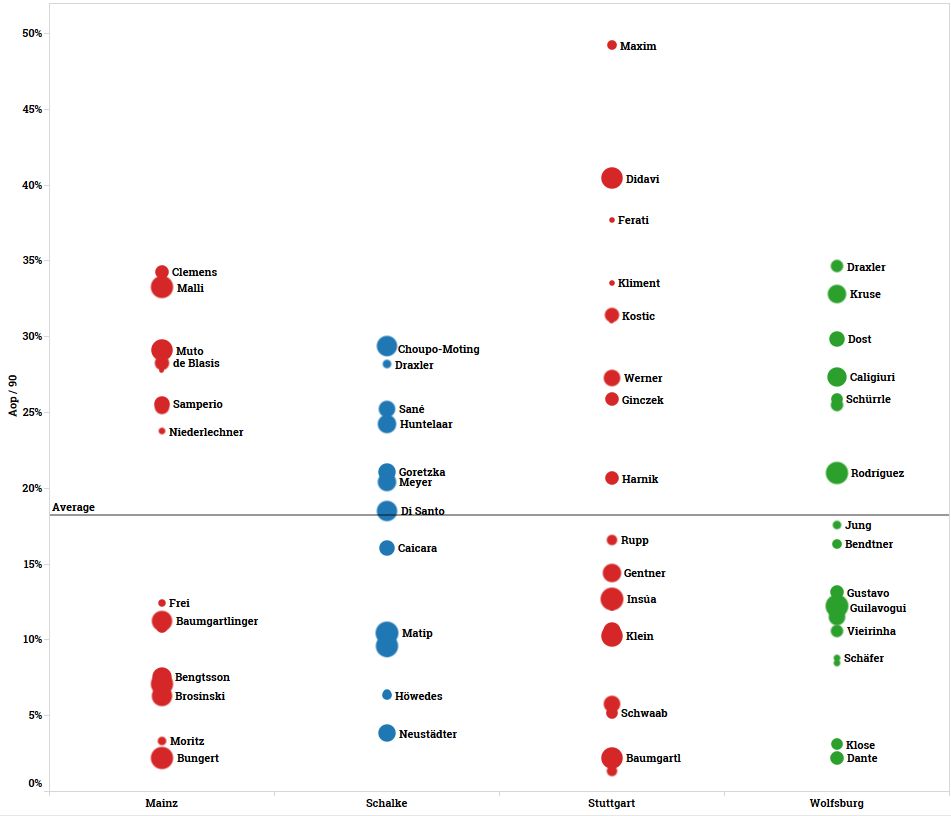
There you have it. Let’s go through each team.
- Augsburg: Unless Caiuby’s numbers stay up there, no one-man team at all.
- Bayern: As mentioned before, no one-man team but a high dependence on five players.
- Bremen: A big gap between their attackers and midfielders might indicate too much isolation. No one-man team though.
- Darmstadt: The classic case of a “two-men team”. Massively dependent on Sandro Wagner and Konstantin Rausch.
- Dortmund: Dependent on their “big three” of Aubameyang, Mkhitaryan and Reus (hidden behind the Armenian). Not alarming.
- Frankfurt: Clearly no one-man team but it’s a broken team. Five players are responsible for attacking, five for defending. Can work, can be an ugly mess with huge gaps.
- Gladbach: Traore, Hazard, Raffael, Stindl. Those four all have the same output. Balanced offense.
- Hamburg: Balanced, the central midfielders are very involved.
- Hannover: A mess that makes no sense. Seems like they lack a gameplan to rely on.
- Hertha: What you’d expect from an ordinary team. Strikers, attacking midfielders, the rest.
- Hoffenheim: Completely reasonable.
- Ingolstadt: The mother of all one-man teams. What’s their plan when Pascal Groß is injured?
- Köln: Another one-man tendency. Anthony Modeste and then a whole lot of nothing.
- Leverkusen: One-man show. Hakan Calhanoglu might inflate his stats with tons of shots, though.
- Mainz: Big gap shows another “broken” team but not dependent on an individual player.
- Schalke: Incredibly balanced, surprisingly. Maybe too balanced even.
- Stuttgart: Didavi (and Maxim if he ever played) are the key pieces. Might want to balance tasks in offense a bit more.
- Wolfsburg: How such a dull and predictable team can be so balanced…
One-man teams
So, to sum up: there are currently three clear one-man teams in the Bundesliga, as Ingolstadt / Köln / Leverkusen’s offensive output is carried by Pascal Groß (playmaker) / Anthony Modeste (finisher) / Hakan Calhanoglu (balanced). For Köln, it’s a bit of a special case, as the numbers show that Jonas Hector plays a high percentage of key passes but his complete lack of shooting made him fall in the AOP.
Furthermore, Darmstadt rely on Wagner & Rausch and Stuttgart are slowly being dragged into one-man territory by Daniel Didavi’s tendency to shoot at will. All other teams are safe for now, injuries in offense probably wouldn’t decrease their output too much. Then again, there’s a lot more to football than shooting and assisting a shot. Unfortunately however, it is far from easy to measure that influence.

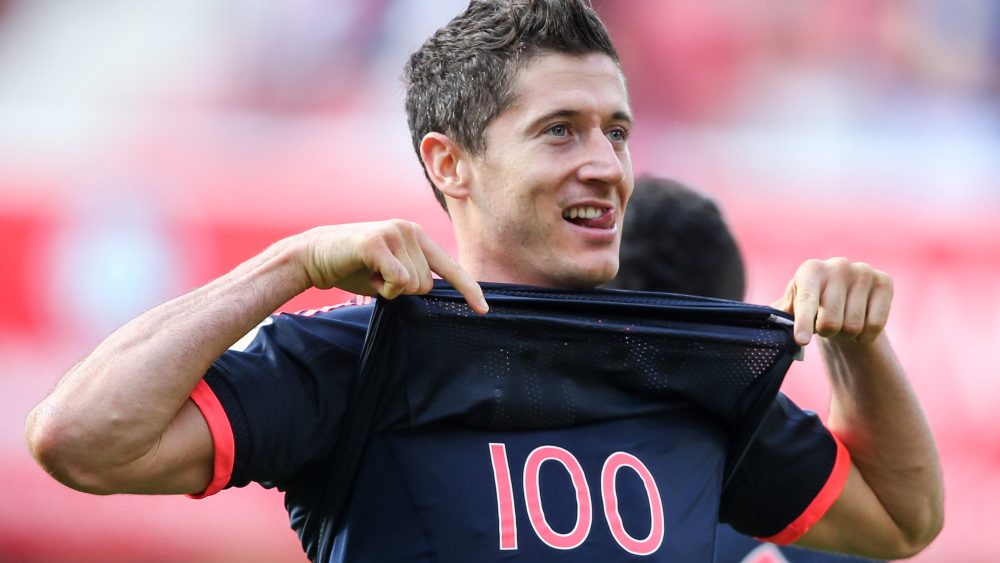






[…] + + Bundesliga: Wie stark konzentriert sich das Offensivspiel auf einzelne Spieler? Club für Club (Miasanrot) + + […]
[…] Berechnung ist hier im Original-Artikel von @redrobbery auf Miasanrot.com genau erklärt: Um auslesen zu können, wie groß der Einfluss einzelner Spieler auf die Produktion […]
[…] wird eine Statistik verwendet, die bereits letzte Saison auf unserem englischen Pendant zum Einsatz […]